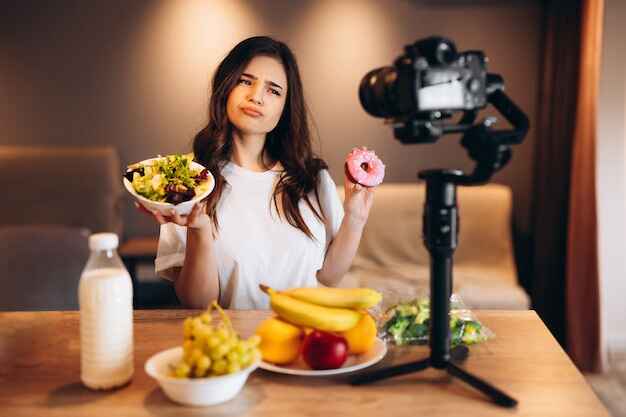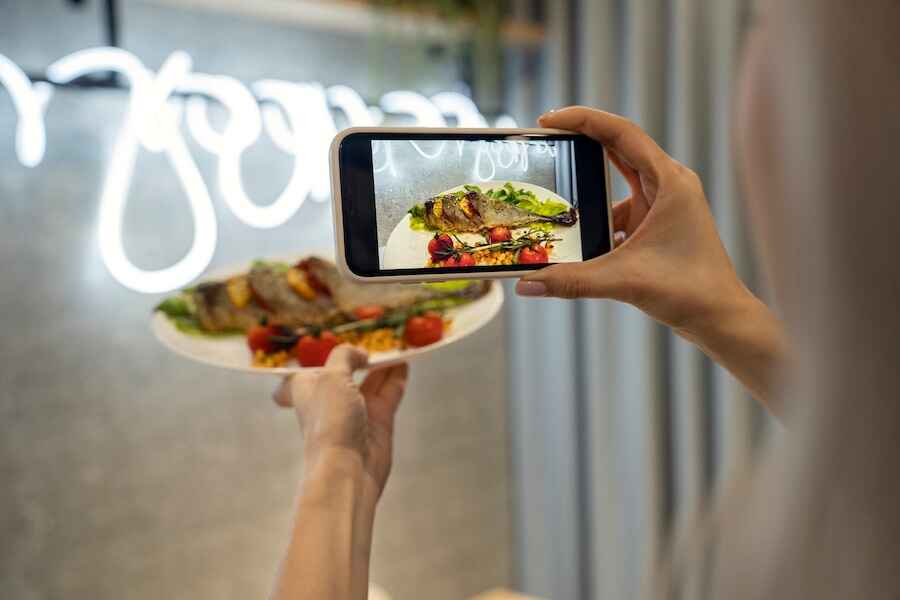-

Step-by-Step Guide to Becoming a Social Media Specialist: Skills, Tools, and Career Tips January 12, 2025
-

AI-Powered Social Media Marketing January 10, 2025
-

How Can an Expert in Social Media Increase LinkedIn Engagement? January 05, 2025
-

How Social Media Networks Have Helped in Building Pinterest Careers January 03, 2025
-

Instagram Creator Studio: A Game-Changer for Content Creators January 01, 2025

The Art of Food Vlogging: Tips and Tricks to Becoming Successful Food Vloggers
Food vlogging has emerged as a vibrant and dynamic space where creativity meets culinary passion. Whether you're a seasoned chef or a culinary enthusiast, the world of food vlogging offers a unique platform to share your love for food and connect with a global audience. But with so many food vloggers already out there, how do you stand out and create content that truly captivates?
In this blog post, we'll delve into the intricate process of creating compelling food vlogs that not only look amazing but also engage your audience on a deeper level. From mastering the art of storytelling to enhancing the visual appeal of your dishes, we'll explore practical tips and strategies to help you build a loyal following. Additionally, we'll discuss effective ways to monetize your content and stay ahead in this competitive yet rewarding field. Let's embark on this culinary journey together and discover the secrets to becoming a successful food vlogger.
Mastering the art of storytelling

Food vlogging is not just about showcasing delicious dishes; it's about telling a story that captivates and connects with your audience. To stand out in the crowded world of food vloggers, you need to master the art of storytelling. Each video should have a unique narrative that draws viewers in and keeps them engaged from start to finish. Think of your video as a mini-documentary where every element, from the ingredients to the final dish, plays a crucial role in the story.
To create engaging content, utilize classic storytelling techniques like plot, character development, and conflict resolution. Start with a hook that grabs the viewer's attention and sets the tone for the rest of the video. Develop your story with a clear beginning, middle, and end. Introduce characters, whether they are your family members, friends, or even yourself, and let their interactions with the food add depth to your narrative. Use conflict, such as a challenging recipe or a cooking mishap, to build tension and keep viewers on the edge of their seats. Resolve these conflicts in a satisfying way that leaves your audience feeling fulfilled.
Personal anecdotes and experiences related to the food you're featuring can add a human touch to your content. Share stories about where you first encountered the dish, the memories it evokes, or the cultural significance it holds. This not only makes your videos more relatable but also creates a deeper connection with your audience. Viewers are more likely to engage with content that resonates with them on an emotional level.
Editing your videos creatively can significantly enhance the storytelling aspect. Use music, sound effects, and transitions to set the mood and pace of your narrative. Background music can evoke emotions and amplify the impact of key moments. Sound effects can add humor or drama, making your story more dynamic. Transitions between scenes should be smooth and intentional, guiding the viewer seamlessly through the story.
Consider collaborating with other food vloggers or influencers to bring diverse perspectives and expand your reach. Collaborations can introduce your audience to new faces and ideas, making your content more dynamic and engaging. It also provides an opportunity to learn from others and gain insights into different cooking techniques and cultures. A social media specialist can help you strategize these collaborations to maximize their impact and reach a broader audience.
By mastering the art of storytelling, you can transform your food vlogging videos from mere cooking demonstrations into captivating narratives that resonate with your audience. Remember, every dish has a story to tell, and it's your job as a food vlogger to bring that story to life.
Enhancing your visual appeal

In the world of food vlogging, visual appeal is paramount. To stand out among the sea of food vloggers, investing in high-quality equipment is a must. A good camera and microphone can significantly enhance the video and audio quality, making your content more professional and engaging. Opt for cameras that offer excellent low-light performance and crisp, high-definition resolution. Similarly, a high-quality microphone ensures that your voice is clear and free from background noise, making your narration and commentary more impactful.
Proper lighting is another crucial aspect of enhancing visual appeal. Natural light is often the best choice, but artificial lighting can also be used effectively to highlight your food and create a beautiful setting. Experiment with different lighting setups to find what works best for your style. Softbox lights, for instance, can provide a diffused, gentle light that minimizes harsh shadows and brings out the vibrant colors of your dishes. Pay attention to the background as well; a clean, well-decorated set can enhance the overall aesthetic and make your videos more inviting.
Once you have captured your footage, the art of video editing comes into play. Professional editing can transform raw clips into polished, captivating stories. Use editing software to cut unnecessary scenes, adjust the pacing, and add transitions that keep the viewer engaged. Color correction and grading can enhance the visual appeal of your food, making it look even more appetizing. Adding background music and sound effects can also elevate the mood and make your videos more dynamic. Consider hiring a social media specialist with editing skills if you need professional help in this area.
Lastly, designing eye-catching thumbnails is essential for attracting viewers and increasing click-through rates. A well-designed thumbnail should be visually appealing and give a glimpse of what the video is about. Use high-quality images, bold text, and vibrant colors to make your thumbnails stand out. Ensure that the thumbnail is consistent with the content of the video to avoid misleading viewers. By focusing on these technical and creative aspects, you can significantly enhance the visual appeal of your food vlogging content and attract a larger, more engaged audience.
Engaging with your audience

goes beyond simply creating compelling content; it involves fostering a sense of community and making viewers feel valued and heard. One of the most effective ways to do this is by actively responding to comments on your videos and social media posts. This not only shows appreciation for their feedback but also encourages further interaction and dialogue.
Hosting Q&A sessions is another excellent strategy to enhance engagement. These sessions provide a platform for your audience to ask questions, share their thoughts, and feel more connected to you as a food vlogger. Additionally, creating interactive content, such as polls, live streams, or challenges, can make your viewers feel like they are part of the content creation process. This inclusive approach not only increases viewer participation but also helps in understanding your audience's preferences and tailoring your content to meet their interests.
Understanding your audience's preferences is crucial for maintaining their interest. Conducting surveys or simply paying attention to the types of videos that garner the most engagement can provide valuable insights. Tailoring your content to meet these preferences shows that you care about what your viewers want, which can significantly boost their loyalty. Moreover, collaborating with other food vloggers or influencers can bring new perspectives and expand your reach, making your content more dynamic and appealing to a wider audience.
Lastly, leveraging social media effectively is key. As a social media specialist, you should be active on various platforms where your audience is most active. Sharing behind-the-scenes content, sneak peeks, and personal stories can humanize you and make your audience feel more connected. By consistently engaging with your audience across multiple platforms, you cultivate a loyal and engaged following, which is crucial for the success of any food vlogging channel.
Monetization strategies

Turning your passion for food vlogging into a profitable venture requires a strategic approach to monetization. One of the most effective methods is collaborating with food brands to create sponsored content. This not only allows you to earn income but also provides an opportunity to promote products you genuinely believe in. By aligning your content with reputable brands, you can build trust with your audience and enhance your credibility as a social media specialist.
Another lucrative avenue is launching personal merchandise or publishing a cookbook. These ventures not only diversify your revenue streams but also strengthen your personal brand. Your audience can connect with you on a deeper level through tangible products that reflect your unique culinary perspective. Additionally, creating online courses or e-books about food vlogging can be a valuable way to share your expertise. Offering consulting services to aspiring food vloggers can further establish you as an authority in the field while generating additional income.
Affiliate marketing is another powerful tool for monetization. By featuring and recommending products in your videos, you can earn commissions through affiliate links. This strategy not only benefits you financially but also provides value to your audience by introducing them to quality products. The key to successful affiliate marketing is authentic endorsements that align with your content and resonate with your viewers.
By exploring these various monetization strategies, you can transform your passion for food vlogging into a sustainable and profitable career. Diversifying your income streams ensures stability and growth, allowing you to focus on creating high-quality content that continues to engage and inspire your audience.
Staying ahead of the competition

In the dynamic and increasingly crowded world of food vlogging, standing out is crucial. One of the most effective ways to differentiate yourself is through innovation and creativity. Experiment with unique recipes, unusual ingredients, or unconventional cooking techniques. By continually pushing the boundaries of what's expected, you can captivate your audience and keep them coming back for more. Staying updated with the latest trends and technologies is also essential. Whether it's new camera equipment, editing software, or social media platforms, being at the forefront of these advancements can give your content a competitive edge.
Building a unique brand identity is another vital strategy for staying ahead of the competition. Your brand should reflect your personality, values, and the unique perspective you bring to food vlogging. Consistency is key here—from your video thumbnails to your social media posts, ensure that every aspect of your online presence aligns with your brand. Leveraging social media effectively is also crucial. As a social media specialist, you should be active on multiple platforms, engaging with your audience, and promoting your content regularly. This not only increases your visibility but also helps foster a loyal and engaged community around your brand.
Continuous learning and adaptation are equally important. The food vlogging landscape is constantly evolving, and what works today might not work tomorrow. Stay curious and open to new ideas, and don't be afraid to pivot your content strategy when needed. Networking and collaborating with other food vloggers can also provide invaluable insights and opportunities. Collaborations can introduce your content to new audiences, while networking can help you stay informed about industry trends and best practices. By staying connected and collaborative, you can ensure that your content remains fresh, relevant, and ahead of the curve.
Conclusion:
Food vlogging is a creative and rewarding journey that combines culinary passion with the art of storytelling. By focusing on engaging narratives, enhancing visual appeal, and building meaningful connections with your audience, you can establish yourself as a standout food vlogger. Pair these efforts with strategic monetization and consistent innovation to turn your passion into a thriving career. Remember, every dish has a story to tell, and with the right approach, you can captivate hearts and taste buds alike. Start your food vlogging journey today and share your love for food with the world!

FAQS
What equipment do I need to start food vlogging?
To start food vlogging, you'll need a good-quality camera for crisp visuals, a reliable microphone for clear audio, and proper lighting equipment to highlight your dishes. Additional tools like tripods and editing software can further enhance your content.
How can I make my food vlogs more engaging?
Focus on storytelling by creating a unique narrative for each video. Use personal anecdotes, showcase behind-the-scenes moments, and involve your audience through interactive content like Q&A sessions or polls.
What are the best ways to monetize a food vlogging channel?
You can monetize your channel through sponsored content, affiliate marketing, merchandise sales, online courses, or consulting services. Collaborating with brands and launching unique products are also effective strategies.
How can I attract more viewers to my food vlogging channel?
Enhance the visual appeal of your videos with high-quality footage, creative editing, and eye-catching thumbnails. Be active on social media, collaborate with other vloggers, and stay updated with trends to expand your audience.
What sets successful food vloggers apart from the rest?
Successful food vloggers combine creativity, storytelling, and high production value. They build a strong personal brand, consistently engage with their audience, and adapt to changing trends in the food vlogging industry.
Comment